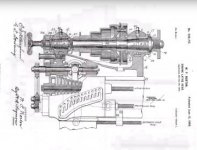Well I got to spend some time with 29837 yesterday and I'm a bit disappointed. The sellers represented it as working well, but there is at least one serious issue.
Positives:
• 14.5" swing over the carriage instead of 12" predicted by cast-in "12x30."
• Motor (230v 1ph 2HP 1725 RPM General Elctric), wiring, and switch all good.
• "TRB" spindle bearings feel & sound fine at speed.
• All spindle and lead screw gearing seems to be intact & no louder than I expect.
• No significant rust
Negatives
• Lead screw reversing mech. cannot be made to work correctly. There seem to be multiple problems here. One is the key holding the lever to its control arm: there's too much free movement there so some of the lever's travel is wasted. Another is that sometimes the gears won't mesh (to start the lead screw turning) unless the spindle is stopped. Finally, even when I can get the gears engaged, one feed direction pops out of gear, stopping the lead screw. Either the detent mechanism needs work or it can't do its job because there's too much wear in the reversing mechanism? At any rate, without a reliable lead screw the lathe's not super useful and it looks like quite a bit of disassembly may be required to repair that reversing mechanism.
• There's quite a bit of wear visible in a 12" section of the lead screw; the thread crests are thinned about 50% in that area. Am I correct in guessing this will primarily affect accuracy of thread cutting actions that travel into or out of the worn area of the lead screw? Is there any other sig. consequence of local wear to the lead screw?
• A three-jaw drill chuck is stuck in the tail stock quill. We took the quill out and tapped pretty hard from the back with a hammer & drift but the chuck arbor wouldn't come out. I can put thi sin my press if the lathe arrives in my shop, but I'd rather know in advance if the quill is damaged.
• It's only a 12 speed. As I'm much more likely to turn smaller diameters than large, I could change the motor pulley ratio to get faster spindle speeds. I suppose my other option would be an upgrade to a 3-phase motor controlled by a VFD. Is there a practical upper spindle speed limit for these machines?
• Being a 12 speed, it doesn't have the quick withdraw feature on the cross slide. I was kinda looking forward to having that...
• There were some crashes into the compound rest at some point and there's a small amount of play in it at the dovetails. I assume a gib adjustment is all it needs, but couldn't experiment at the time.
• None of the original accessories are present: no taper attachment, no steady rest, etc. The three chucks (two 8" and a 10" 3-jaw) appear to be Chinese and are a bit rusty.
• There's not a lot of tooling with it. A few tool holders, a couple boring bars made for HSS cutters, live & dead centers, and a bunch of 3MT shank drills.
• The family members selling the lathe disagree on whether any of the tooling is included in the price, and an influential family member wants to negotiate the price of each component separately.
• Asking price is $1,500 with no delivery (only loading assistance) included. This was firm before the feed reversing mechanism problem was revealed. I was prepared to be happy with the price if the tooling were included—metal lathes sell fast here in Portland and rarely come up in a size I can accommodate at this price—but now I'm much less certain of the value. I can't bring a $1,500 1T boat anchor into my life if I can't make it function well pretty quickly & easily! What do y'all think about the price, given the problems identified above?
One more question: what do people do for turning in collets with a machine like this? It looks like MT5 > ER32 and MT5 > 5C adaptors are available... would I make my own draw tube to fit my spindle, or is there another way to use modern collets on these machines? Working close to a collet I'd be in an area where the ways & lead screw look like new, so that'd be one way to sidestep some of the wear I see.



